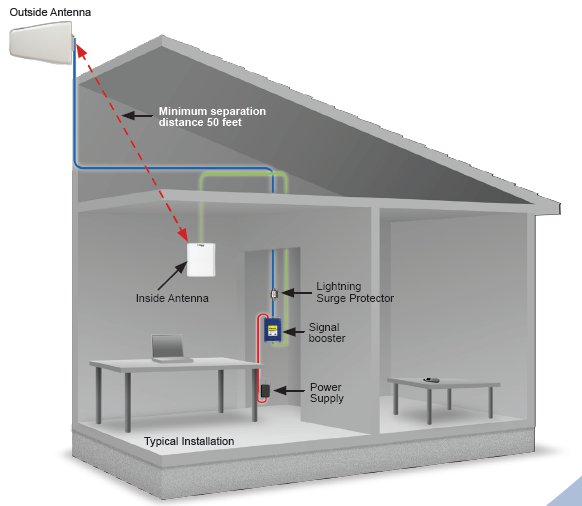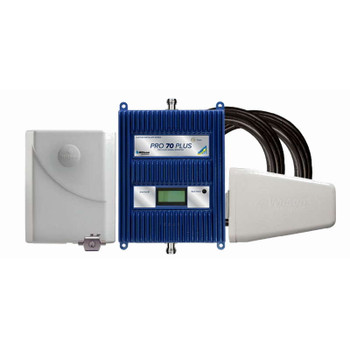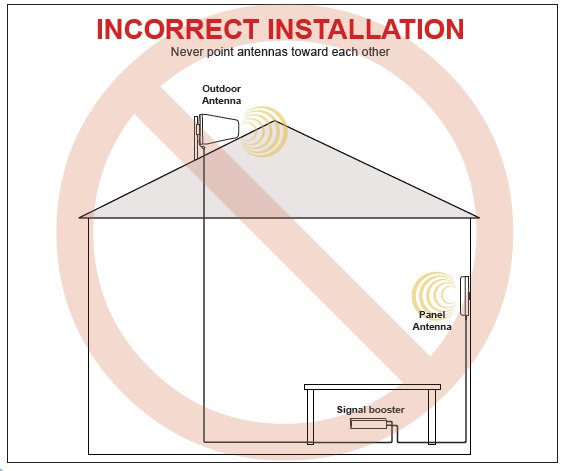Wilson AG Pro 70 Booster Installation
Planning Your Wilson Electronics AG Pro 75 Installation
This page will help you properly install your Wilson Electronics AG Pro 75™ In-Building Cellular Signal Booster. It is important to read through all of the installation steps for your particular application before installing any equipment. Read through the instructions, visualize and/or draw where all the equipment will need to be installed and do a soft installation before mounting any equipment.
Estimating Coverage Area
By gathering a few pieces of information, you can estimate the expected amplifier coverage area. Information you'll need is Outside Signal Strength, Cable Length, Antenna Gains and Cellular Frequency from your service provider in your area. Read more on Calculating Cellular Booster Coverage Area.
System Components
- Wilson AG Pro 75 Cellular Amplifier & Power Supply
- Inside Antenna(s)
- Outside Antenna(s)
- Cable - To inside and outside antenna(s)
- Lightning Surge Protector (Strongly Recommended)
- Splitter(s) - For multiple inside antennas (Optional)
- Combiners - For multiple outside antennas (Optional)
Easy Installation
With a little planning and bit of hand tool skill, installing the Wilson AG Pro 75 repeater system is easy. Selecting the right antennas and cable with matching connectors will enable you to just connect everything together. The biggest challenge will be running cable and mounting the antennas.
1. Select a location to install the signal booster. The best location is usually indoors, close to a power source. The location mus be away from excessive heat, direct sunlight, moisture and has proper ventilation. Some air circulation will keep the amplifier cooler. Do not place the signal booster in an air-tight enclosure.
2. Select a location on the roof of the building to install the outside antenna. Use a cell phone in test mode to find the strongest signal from the cell tower. Use this link to find test mode function for your particular cell phone.
3. Select a location for the inside antenna, preferably in the center of where the signal needs to be amplified. Separation distance between inside and outside antennas must be a minimum of 50 feet. If the outside signal is very strong and the installation requires covering a very large area, more antenna separation will be required. Typically, the more amplifier gain, the more antenna separation required.
4. Run the outside antenna cable to the signal booster and attach it to the connector labeled “Outside Antenna” on the signal booster. Run the inside antenna cable to the signal booster and attach it to the connector labeled “Inside Antenna" on the signal booster. Note: Be careful when plugging the connector in so as not to bend the center pins on the connectors.
5. Verify that both the outside antenna and the inside antenna are connected and check that all connections are tight, before powering up the signal booster. Lightning surge protection is recommended for all in-building installations.
6. AG Pro 75™ Signal Booster has been packaged with the gain control knobs adjusted to the highest gain position. If one or both of the lights are blinking red please refer to page 4.
Warning: Connecting the signal booster directly to a cell phone with use of an adapter will damage the cell phone.
Typical Setup

Powering up a Wilson Electronics Signal Booster
1. To verify proper installation of the signal booster and antennas, make sure that the distance between the inside and outside antennas is a minimum of 50 feet.
2. Never point the front of a directional antenna toward the other, inside or outside, antenna. See below.
3. Ensure that both the outside antenna coax cable and the inside antenna coax cable are connected to the signal booster and the connections are tight before powering up the signal booster.
4. Plug the 6-volt power supply into the signal booster input marked “6V DC” (carefully, to avoid damaging the center pin) and then into a wall outlet.
5. If the signal booster has a red light, or a blinking red light, please see page 4.
6. If you know that only one frequency band (800 or 1900) is available in your coverage area (or going to be used), reduce the gain control on the frequency band that is NOT in use to the minimum. This will reduce the power consumption of the signal booster.
7. Using multiple boosters in one installation could cause degraded cell tower operation.
Understanding the Signal Booster Lights and Troubleshooting
1. Blinking Green
If the signal booster is blinking green, the signal booster is operating properly. If you are happy with the coverage area in your building, then you are done.
2. Blinking Red
The signal booster is experiencing receiver overload, see troubleshooting tips below.
3. Solid Red
The signal booster has shut down to prevent an oscillation, see troubleshooting tips below.
If after the initial 15 minutes you are not done with the installation, the signal booster can be reset and enter installation mode again by disconnecting and reconnecting the power supply from the booster.
Troubleshooting Tips
Green
The indicator lights on the signal booster will be a solid green when the unit is powered up and working properly. (After the 15 minute installation period).
Blinking Red Light
The signal booster has protection shut off circuits to prevent the disruption of cell towers.
If one or both lights are blinking red, this indicates that the signal from a cell tower is overloading the booster and the booster has shut down on that frequency.
Reposition the outside antenna away from the cell tower, or turn the gain control knob counter clockwise to reduce the gain until the light turns green.
If the red light is still blinking with the gain control adjusted all the way counter clockwise, contact Wilson Electronics Technical Support Team for assistance: 866-294-1660.
Solid RED
If the signal booster indicator light is a solid red, this indicates the booster has shut down on the frequency indicated to prevent an oscillation. First, make sure that all the connections are tight. Then move the inside and outside antennas farther apart or reduce the gain of the booster by rotating the gain control, corresponding to the red light, counter clockwise until the light turns green.
When you are turning down the gain, you are reducing the inside coverage area. If after turning down the gain, your coverage area is too small, and you want it larger, then move the inside and outside antennas farther apart until the gain can be raised.
Warnings and Recommendations
Warning: The Directional antenna must always be located so the back or side points to the inside antenna. Never point the front of the Directional antenna toward the inside antenna – this is to prevent oscillation.
Warning: Connecting the signal booster directly to the cell phone with use of an adapter will damage the cell phone.
Warning: Connect both the outside and inside antenna cables to the signal booster before powering up the signal booster.
Warning: Use only the power supply provided in this package. Use of a non-Wilson Electronics product may damage your equipment.
Warning: RF Safety: FCC regulations require that any fixed outside antenna used with this signal booster may not have gain (less cable loss) that exceeds 15 dBi and must be located at least 30 inches from all people. Inside antennas must not exceed 7 dBi gain (less cable loss) in the 800 MHz band or 10 dBi gain (less cable loss) in the 1900 MHz band and must be located at least 8 inches from all people.
Warning: Verify that both the outside antenna and the inside antenna are connected to the signal booster before powering up the signal booster.
Note: Lightning surge protection is recommended for all in-building installations.
Reasons for Weak Cellular Signals
Anyone who uses a cell phone or cellular data card knows the frustration of not being able to connect to or maintain a strong cellular signal. When this occurs, it is generally due to one of two reasons:
1. Location of the Nearest Cell Tower – Cell towers are situated to provide broad coverage; however, there are many areas in which signal strength may be reduced by placement of the towers themselves or local government restrictions on the height. Rural areas generally have fewer cell towers than urban regions.
2. Natural and Man-Made Obstructions – Signal strength can also be negatively affected by trees, hills, weather, buildings and other obstructions. You may be relatively close to a cell tower but still unable to make a call. This often occurs in homes, offices and other buildings in which stucco, concrete or metal walls may block the signal. Your booster works with two antennas. The inside antenna communicates with your cell phone and the outside antenna communicates with the cell tower.
The outside antenna receives the outside signal and sends it through the coax cable to the booster, where it is amplified and transmitted through the inside antenna into the room. When the inside antenna picks up a signal from your cell phone, the signal booster amplifies that signal and transmits it through the cable to the outside antenna and back to the cell tower. Note: The booster will only boost if a signal is available.
Amplifier Operation
Operation is subject to the following two conditions:
(1) This device may not cause interference and
(2) this device must accept any interference
Disclaimer: The information provided by Wilson Electronics, Inc. is believed to be complete and accurate. However, no responsibility is assumed by Wilson Electronics, Inc. for any business or personal losses arising from its use, or for any infringements of patents or other rights of third parties that may result from its use.
-


WilsonPro 70 PLUS Building Signal Booster System DIR/PNL [50 Ohm]
WilsonPro
*** The Wilson Pro 70 and Pro 70 Plus has been replaced by the weBoost Office 100 Signal Booster System The WilsonPro 70 Plus Commercial Building Cellular Signal Booster System offers up to 25,000 sq. ft. (outside signal...- SKU:
- AP463127
- Availability:
- Discontinued - Replaced By weBoost Office 100
- Discontinued:
- This System Has Been Replaced By The New weBoost Office 100 Signal Booster System

